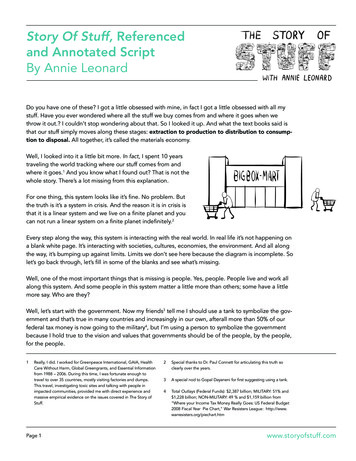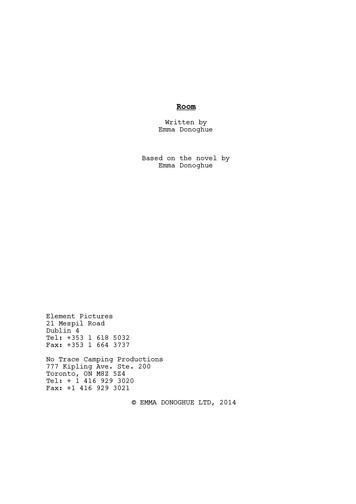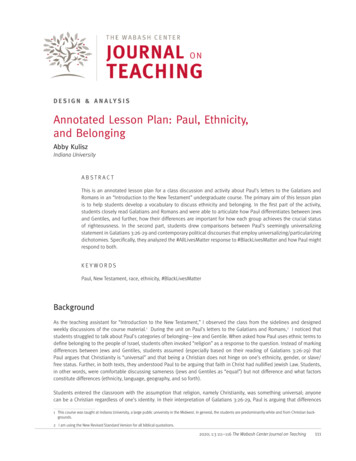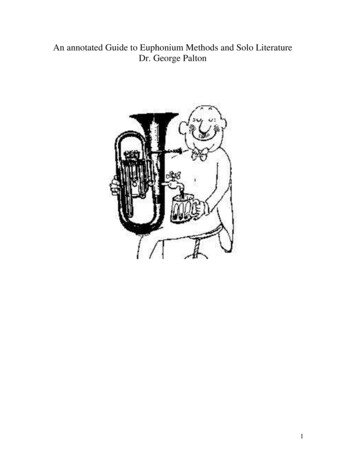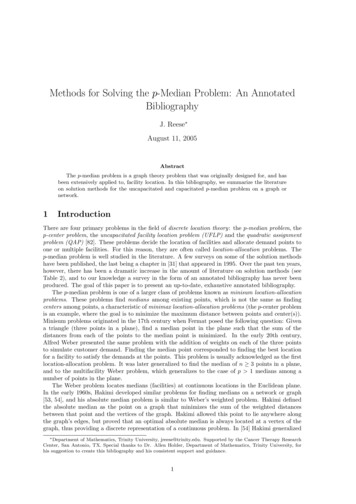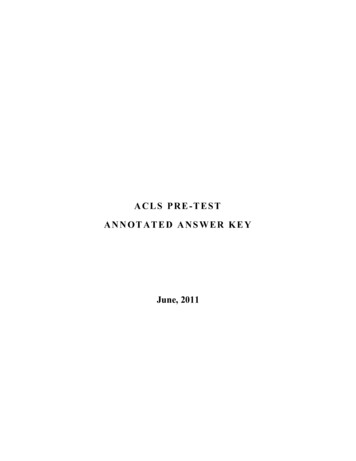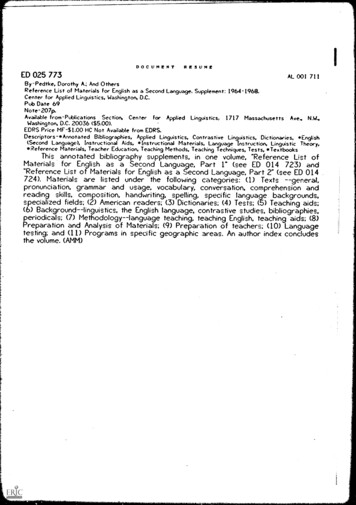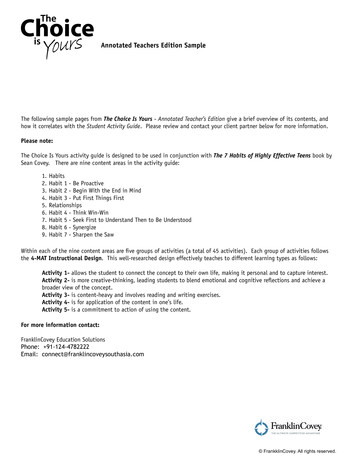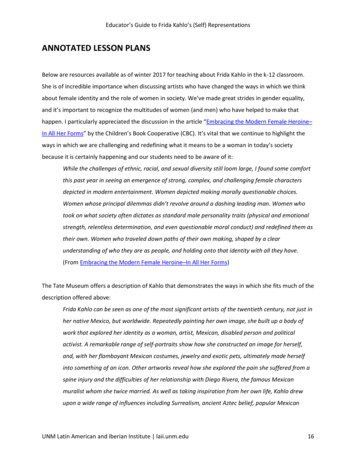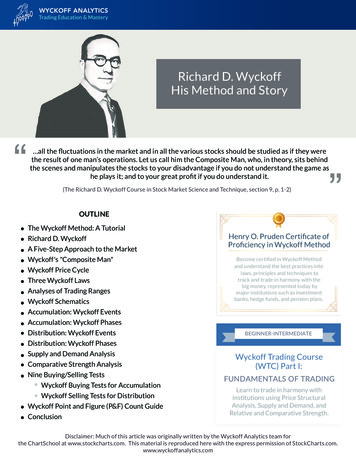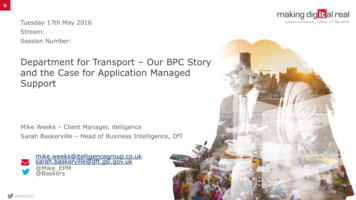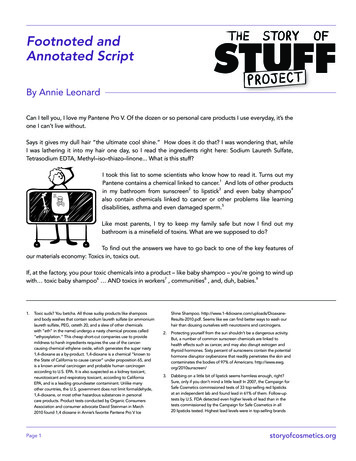
Transcription
Footnoted andAnnotated ScriptBy Annie LeonardCan I tell you, I love my Pantene Pro V. Of the dozen or so personal care products I use everyday, it’s theone I can’t live without.Says it gives my dull hair “the ultimate cool shine.” How does it do that? I was wondering that, whileI was lathering it into my hair one day, so I read the ingredients right here: Sodium Laureth Sulfate,Tetrasodium EDTA, Methyl–iso–thiazo–linone. What is this stuff?I took this list to some scientists who know how to read it. Turns out myPantene contains a chemical linked to cancer.1 And lots of other productsin my bathroom from sunscreen2 to lipstick3 and even baby shampoo4also contain chemicals linked to cancer or other problems like learningdisabilities, asthma and even damaged sperm.5Like most parents, I try to keep my family safe but now I find out mybathroom is a minefield of toxins. What are we supposed to do?To find out the answers we have to go back to one of the key features ofour materials economy: Toxics in, toxics out.If, at the factory, you pour toxic chemicals into a product – like baby shampoo – you’re going to wind upwith toxic baby shampoo6 AND toxics in workers7 , communities8 , and, duh, babies.91.Toxic suds? You betcha. All those sudsy products like shampoosand body washes that contain sodium laureth sulfate (or ammoniumlaureth sulfate, PEG, ceteth 20, and a slew of other chemicalswith “eth” in the name) undergo a nasty chemical process called“ethyoxylation.” This cheap short-cut companies use to providemildness to harsh ingredients requires the use of the cancercausing chemical ethylene oxide, which generates the super nasty1,4-dioxane as a by-product. 1,4-dioxane is a chemical “known tothe State of California to cause cancer” under proposition 65, andis a known animal carcinogen and probable human carcinogenaccording to U.S. EPA. It is also suspected as a kidney toxicant,neurotoxicant and respiratory toxicant, according to CaliforniaEPA, and is a leading groundwater contaminant. Unlike manyother countries, the U.S. government does not limit formaldehyde,1,4-dioxane, or most other hazardous substances in personalcare products. Product tests conducted by Organic ConsumersAssociation and consumer advocate David Steinman in March2010 found 1,4 dioxane in Annie’s favorite Pantene Pro V IcePage 1Shine Shampoo. 2010.pdf. Seems like we can find better ways to wash ourhair than dousing ourselves with neurotoxins and carcinogens.2.Protecting yourself from the sun shouldn’t be a dangerous activity.But, a number of common sunscreen chemicals are linked tohealth effects such as cancer, and may also disrupt estrogen andthyroid hormones. Sixty percent of sunscreens contain the potentialhormone disruptor oxybenzone that readily penetrates the skin andcontaminates the bodies of 97% of Americans. http://www.ewg.org/2010sunscreen/3.Dabbing on a little bit of lipstick seems harmless enough, right?Sure, only if you don’t mind a little lead! In 2007, the Campaign forSafe Cosmetics commissioned tests of 33 top-selling red lipsticksat an independent lab and found lead in 61% of them. Follow-uptests by U.S. FDA detected even higher levels of lead than in thetests commissioned by the Campaign for Safe Cosmetics in all20 lipsticks tested. Highest lead levels were in top-selling brandsstoryofcosmetics.org
THE STORY OF COSMETICSSo let’s take a closer look at this toxic outrage where it seeps into our lives every day -- in the bathroom.The average woman in the U.S. uses about 12 personal care products daily. The average man, about 6.10Each product contains a dozen or more chemicals.Less than 20% of all chemicals in cosmetics have been assessed for safety by the industry’s safety panel11so we just don’t know what they do to us when we use them. Would you fly on an airline that onlyinspects 20% of its planes?Of course, not all of these chemicals are dangerous. But we know that many are. Some are carcinogens– that means they can cause cancer.12Others are neurotoxins and reproductive toxins; proven to mess up brain development and reproductionin animals.13 Wait a minute, we’re animals too!It’s like a giant experiment. We’re using all these mystery chemicals and just waiting to see what happens.14One thing we do know is that they’re getting inside us.I had my body’s toxicity levels tested, and I’m loaded with things like mercury, flame retardants, triclosanand lead!15 We all are.16 Even babies are being born pre-polluted.17Now I know we can’t live in a lead free world, but do they have to put lead in our lipstick?18L’Oreal, Maybelline, Cover Girl and Revlon. In 2009, independenttesting of children’s face paints commissioned by the Campaignfor Safe Cosmetics found 10 out of 10 products tested containedlead. Lead is a proven neurotoxin that can cause learning, languageand behavioral problems such as lowered IQ, reduced schoolperformance and increased aggression. It can also impact fertility,including increasing risk for miscarriage and reducing sperm quality.Early-life lead exposure can even increase risk for Alzheimer’s andParkinson’s disease. Pregnant women are particularly vulnerable tolead exposure, because lead easily crosses the placenta and entersthe fetal brain where it can interfere with normal development.Experts say there is no safe level of lead exposure for childrenand the Centers for Disease Control and Prevention recommendthat parents avoid using cosmetics on their children that could becontaminated with lead. See: www.safecosmetics.org/lipstick andwww.safecosmetics.org/prettyscary4.We’re washing our kids in tubs full of toxic suds! Dozens of children’sbath products analyzed at an independent laboratory in 2009 werefound to contain formaldehyde and 1,4 dioxane, two chemicalsthat cause cancer in lab animals and are classified as probablehuman carcinogens. (See note 1). Popular brands containing thesechemicals include Johnson’s Baby Shampoo, Sesame Street BubbleBath and Huggies Naturally Refreshing Cucumber & Green TeaBaby Wash. The companies argue that each product contains justlow levels of these toxins – but there shouldn’t be any carcinogensin baby shampoo at all. Period. The good news is, many companieshave already figured out how to make excellent products withoutthe toxic chemicals. To learn more check out: http://www.safecosmetics.org/toxictubPage 25.Ah, the sweet smell of reproductive toxics. Many fragrancecontaining products – from hairsprays, to deodorants, perfumesand cologne – contain the chemical diethyl phthalate (DEP), whichis linked in recent human studies to sperm damage in adult men,abnormal reproductive development in infants and AttentionDeficit Disorder in children. To learn more, check out this DEPscience review on page 21 of this report: http://safecosmetics.org/downloads/NotSoSexy report May2010.pdf6.See note 4.7.Despite the fact that workers in nail salons are constantly exposedto hazardous cosmetic chemicals, there is shockingly little healthresearch available about the health impacts on this population. Weshouldn’t be surprised, though, since cosmetic companies are notrequired to monitor the health effects of highly exposed workerpopulations, and the government isn’t conducting this researcheither. What we do know is cause for concern: Nail salon workersare exposed to many problematic chemicals such as phthalates,toluene, formaldehyde, acetone, methylacrylates and more. Theseexposures often occur in poorly ventilated spaces to a workforcecomprised mainly of women of childbearing age, who are especiallyvulnerable to toxic exposures. Occupational health researchsuggests adverse effects on attention, information processing andincreased occupational asthma. See WVE report, “Glossed Over:Health Hazards Associated with Toxic Exposure in Nail eports/issuereports/WVE.NailSalon.Report.pdfHair salon environments are also a health concern. An increasingnumber of studies of humans link long-time hair dye use with cancer,storyofcosmetics.org
THE STORY OF COSMETICSMaybe I just bought the wrong thing.At the store, the choices seem endless. I can get lipstick in 49 shades or shampoo for hair that’s too dry,oily, fine, limp, or frizzy. But what about the choices that really matter? Like the choice to buy productsthat are safe?It turns out the important decisions don’t happen when I choose to take a product off the shelf.They happen when companies and governments decide what should be put on the shelves.So who are these companies? This is Procter & Gamble. They’re the ones offering me “Herbal Essences,”the number two shampoo in the country.It contains toxic petrochemicals – made from oil.19Since when is oil an herb?On cosmetics labels, words like “herbal”, “natural”, even “organic” have no legal definition.20 Thatmeans anybody can put anything in a bottle and call it natural. And they do. I mean, can you imagine atop seller called “petro-essences?” Gross.What’s even nastier are hair relaxers marketed to 5 year olds, and skin whitening creams. These are supertoxic 21 both in their ingredients and in the message they send about what beauty is.including bladder cancer, non-Hodgkin’s lymphoma, and multiplemyeloma. See http://www.cosmeticsdatabase.com/research/coaltar hair dye.php and http://www.ncbi.nlm.nih.gov/pubmed/19092492?dopt AbstractPlus and s a pretty simple equation: toxics in, toxics out. The chemicals usedin cosmetics end up polluting our communities during production(http://scorecard.org/ or http://scorecard.org/env-releases/us-map.tcl) and after we wash them down the drain or throw them away.Recent research indicates that toxic cosmetic ingredients are endingup in our drinking water, rivers and lakes and even in the sewagesludge spread on our food-producing farm fields.Triclosan, a common chemical used in anti-bacterial hand soap,toothpaste, facewash, deodorant, a host of personal care products,is one example of a chemical that poses hazards throughoutits lifecycle. Triclosan persists in the environment, breaks downinto substances highly toxic to wildlife, pollutes the human body(it’s been found in breast milk and the cord blood of newbornbabies), and poses health risks that are barely studied and poorlyunderstood. Triclosan is linked to liver and inhalation toxicity.Low levels of triclosan may disrupt thyroid function. Wastewatertreatment does not remove all of the chemical. Triclosan ends upin lakes, rivers and water sources, where it is very toxic to aquaticlife. Triclosan also can degrade into a form of dioxin, a class ofchemicals linked to a broad range of health problems includingcancer, and new research shows that triclosan in tap water can reactwith residual chlorine from standard water disinfecting proceduresto form a variety of chlorinated byproducts, including chloroform,a suspected human carcinogen. An advisory committee to thefederal Food and Drug Administration has found that household usePage 3of antibacterial products provides no benefits over plain soap andwater. The American Medical Association recommends against usingtriclosan in the home, because it may encourage bacterial resistanceto antibiotics. See http://www.ewg.org/water/downthedrain, ntaminants/whatis-lurking-in-your-soap/, http://www.ewg.org/reports/triclosan 0526134152.htm9.Our babies are being born pre-polluted. This is just SO wrong! Ina 2006 study from Mt. Sinai Medical Center and EnvironmentalWorking Group (EWG) called “The Pollution in Newborns,”researchers analyzed the umbilical cord blood of newborn infantsand detected an average of 200 industrial chemicals known to betoxic in every baby. p. In a 2009 study, EWG and Rachel’s Networkdetected synthetic fragrance chemicals Galaxolide and Tonalidefor the first time in umbilical cord blood samples. http://www.safecosmetics.org/article.php?id 60110. Based on Environmental Working Group, June 2004 survey of 2,300people. Women use an average of 12 personal care products a daycontaining about 180 chemicals; men use an average of 6 productscontaining about 85 chemicals. s.php11. This stuff is barely getting tested. As of January 2010, the CosmeticsIngredients Review (CIR) panel – the industry funded panel thatis charged with assessing the safety of ingredients in cosmetics –assessed 1,594 cosmetic ingredients for safety, out of the 12,500ingredients that FDA estimates are used in cosmetics. This is basedon an Environmental Working Group assessment of chemical reviewlists published by CIR. The companies say they do a lot of their owntesting, but these studies typically look for short-term health effectsstoryofcosmetics.org
THE STORY OF COSMETICSOoh, here’s Estee Lauder offering me a chance to help find a cure for breast cancer.That’s nice. But wait.they’re also using chemicals linked to cancer. 22 Don’t you think the best way forEstee Lauder to fight cancer is to stop using those chemicals in the first place? 23So really, I get to choose between meaningless claims on a bottle. But these guys get the real choiceabout what goes into those bottles.And that happens back here at the factories where they’re formulated.Why do the makers of these products use all these toxics, are they trying to poison us?No, they’re just working from a 1950s mindset when people were totally swept upin “better living through chemistry”. 24In all that excitement, they forgot to worry about human health impacts.That was years ago, and they are still using these same old toxic chemicals. Today big cosmeticscompanies say the doses of poison in their products are small enough to be harmless.Yeah maybe if you use them once a year!such
Annotated Script By Annie Leonard Can I tell you, I love my Pantene Pro V. Of the dozen or so personal care products I use everyday, it’s the one I can’t live without. Says it gives my dull hair “the ultimate cool shine.” How does it do that? I was wondering that, while I was lathering it into my hair one day, so I read the ingredients right here: Sodium Laureth Sulfate, Tetrasodium .
